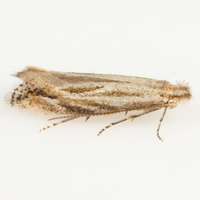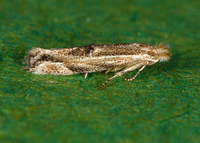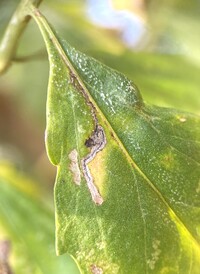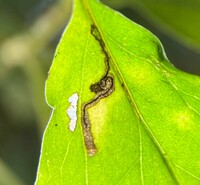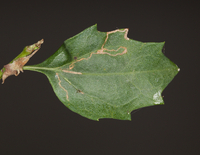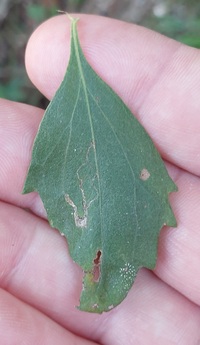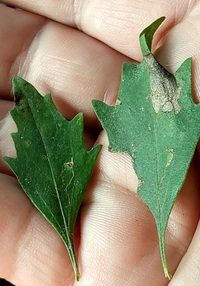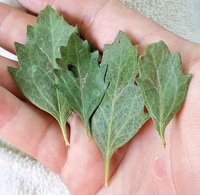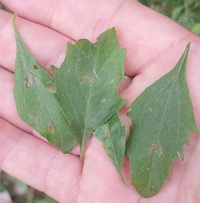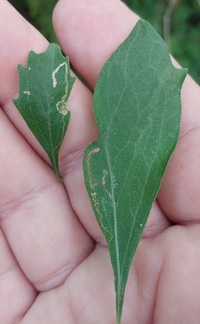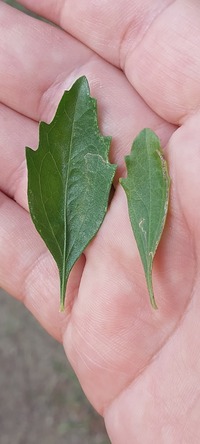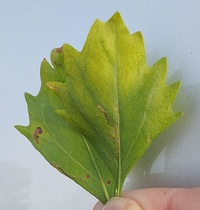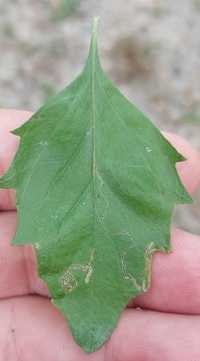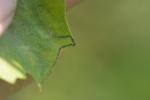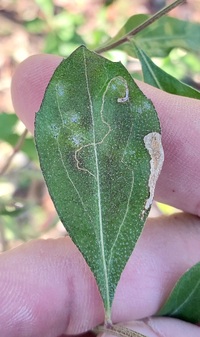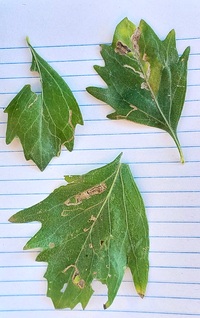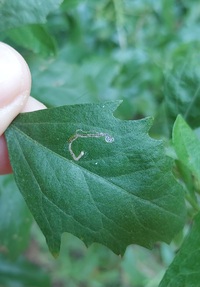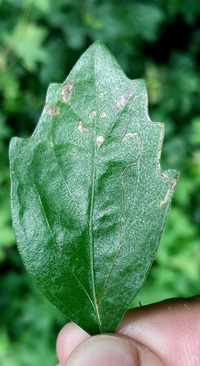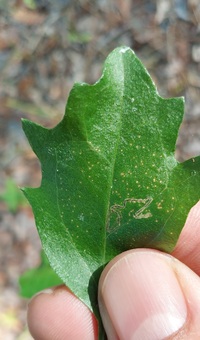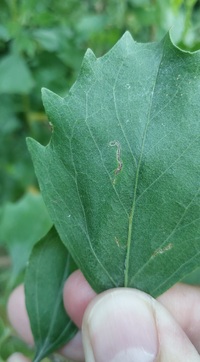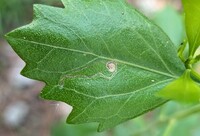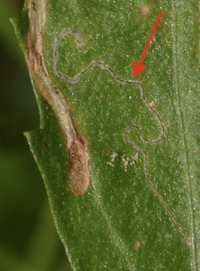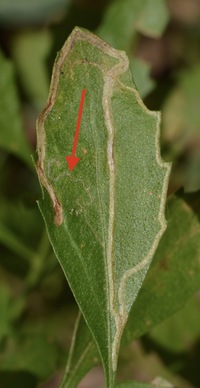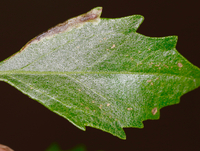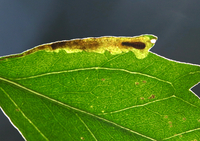Identification
Field Guide Descriptions: Online Resources: MPG , BugGuide , iNaturalist , Google , BAMONA , GBIF , BOLD Technical Description, Adults: Braun's (1963)Technical Description, Immature Stages: Braun's (1963), Palmer and Diatloff (1987)
Adult Markings: Braun's (1963) monograph on North American species of Bucculatrix remains the authoritative work on this group. The following is based on her description from studies of 78 specimens from throughout the range of this species. The face is white, and in darker specimens the scales are minutely brown-tipped. The tuft is white with brown centrally. The eye-cap is white with pale brown specks, and the antennal stalk is pale luteous with narrow silvery annulations. The thorax is whitish. The forewing is overlaid with reddish brown, fuscous-tipped and fuscous scales, so densely in the darker specimens as to obscure the whitish ground color. From before the middle of the costa, there is a narrow, very oblique, brownish fuscous streak (sometimes faint or obsolete in pale specimens) that is narrowly separated from a second, very oblique, brownish fuscous costal streak. The second streak becomes longitudinal in the middle of the wing, with its apex directed toward a group of black raised scales on the middle of the termen that continues to the apex as a line of black scales. The second costal streak is separated from a broadly triangular, dusky costal area by a narrow whitish streak which curves above the raised scales on the termen. From the base of the wing, parallel to and above the fold, there is a narrow straight white streak, (distinct in darker specimens) that extends for more than half the wing length. Along the fold from the base there is a broader stripe of fuscous-tipped scales. Beyond the middle of the dorsum, there is an oblique, curved, brown or fuscous spot. The spot has a patch of black raised scales on its inner edge, and is indistinctly and irregularly margined with the whitish scales of the ground color. A curved line of black-tipped scales in present on the cilia from the costa to the tornus. The hindwings and cilia are pale gray. The legs are pale straw-colored, with the tarsal segments white and narrowly tipped with black. The abdomen is fuscous above. Most of the records for B. ivella are based on leaf mines or adults reared from cocoons on Baccharis halimifolia . This may be the most effective way to obtain adults that are accurately identified. Some of the features that help to distinguish this species from other Bucculatrix include forewings that are pale to darker ocherous (not whitish or whitish ocherous), the absence of silvery markings on the forewings, the presence of a well-defined apical ciliary line, and the presence of a series of dark brown and white streaks on the forewing. The oblique costal and dorsal dark streaks are very oblique relative to other forms. The wing markings of this species are similar to those of B. ambrosiaefoliella , but in B. ivella the dark streaks are more oblique, and the white line above the fold is longer and more clear-cut (Braun, 1963).
Wingspan: 6.5 to 7.5 mm (Braun, 1963)
Adult Structural Features: The male and female genitalia, along with associated scale tufts and patches, are distinctive and are described and illustrated by Braun (1963). The following are her verbatim descriptions. Males: cucullus of harpe with heavy short modified setae; socii rounded, widely separated, setose; on margin of tegumen below each socius, a sharp curved hook; anellus conical; aedeagus broad at base, tapering to the slender tip; vinculum rounded anteriorly, a quadrate projection posteriorly. Scale sac small. Females: a circular hyaline depression near lateral margin of segment 8; near posterior lateral margin a low rounded lobe bearing a tuft of slender scales; margin of ostium with diverging sclerotized points; ductus bursae sclerotized in posterior half of segment 7, thence very narrow and entering bursa near posterior margin of 6; signum elongate, nearly longitudinally placed, its halves appearing as two parallel bands on the elongate bursa; signum ribs irregularly spined, at intervals a rib with very large and strongly sclerotized teeth. The most distinctive character of the male genitalia is the pair of hooks on the margin of the tegumen. For females, it is the pointed processes at the margin of the ostium, and especially the elongate signum with heavy teeth on some ribs (Braun, 1963).
Adult ID Requirements: Identifiable from good quality photos of unworn specimens.
Immatures and Development: The following summary of the larval life history is based primarily on Palmer and Diatloff's (1987) detailed studies of life stages both in the laboratory and field. The female cements whitish, translucent eggs to the leaf surface, usually along the upper surface of the midrib of the leaf. Larvae hatch in 7-11 days and enter the leaf tissue directly where they begin mining the parenchyma. With time, the larvae produce distinctive threadlike tracks with black frass. These initially follow a leaf vein, but eventually become irregular and serpentine. Larvae spend the first, second, and part of the third instars in their mines, then leave and spin flat, thin "molting cocoons" under which they molt. The molting cocoons are thin sheets of lustrous, papery white silk (Eiseman, 2019). The fourth and fifth instars are external feeders and consume leaf tissue in patches on only one side of the leaf. Larvae feed on both the upper and lower leaf surfaces, but are usually more common on the undersides of leaves. A second "molting cocoon" is formed at the end of the fourth instar. Pupation occurs within characteristic ribbed cocoons spun on the leaves and stems of the host plant, but occasionally on neighboring plants or in ground debris. The cocoon is slender, pure white, about 6.5 mm long, with 6–7 ridges, and is often spun over the midrib on the upper leaf surface (Eiseman, 2019). Before eclosion, the pupa thrust through the anterior end of the cocoon. The pupal case remains attached to the cocoon after the adult emerges.
Larvae ID Requirements: Identifiable from good quality photos, especially where associated with known host plants.

 »
»